


| [ Previous ] [ Next ] |

|
It's less than an hour's drive from Drayton Hall to Charleston's historic district, which is one of the most beautiful in the country. Many of its historic sites date from the Civil War, including most of the parade of glorious homes that stretch along the South and East Batteries.
| There are a number of places in the city that I did want to visit and photograph, but we basically ran out of time. Heather had never visited the city before, so we did the scenic walk along the Batteries, but we only caught a couple of places relevant to our period. We walked right past Billy Washington's house, but I'd forgotten the guide book in the hotel, and we never quite figured out which one it was. (I corrected that oversight when we returned to the city a year later, after the Tarleton Symposium.) Washington married a local girl, and settled in the Carolinas. This was their town house -- they also had a plantation somewhere out of town. |
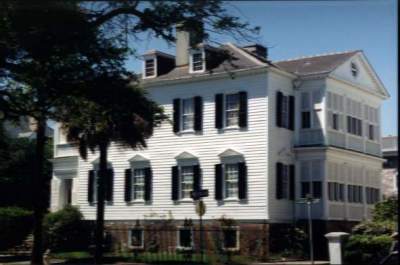
|
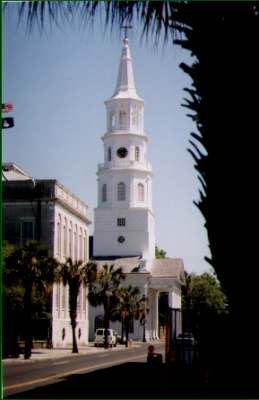
| The intersection of Broad and Meeting Street picked up the nickname "the four corners of law" because the buildings located there are Charleston City Hall and St. Michael's Episcopal Church (both shown in the photo) on the east side, and county and federal court houses located on the west corners. |
| St. Michael's predates the Revolution, and is surrounded by a delightful little burying ground which hosts several famous residents including Governor Rutledge and a member of the Pinckney clan. (If you've picked up the notion that I have an interest in graveyards -- or, rather, with pre-20th century funerary art -- you'd be entirely correct.) |
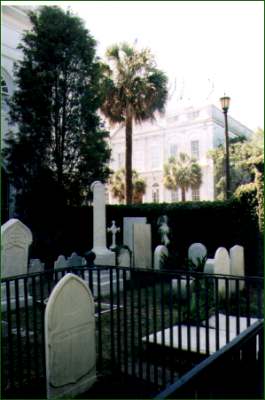
|
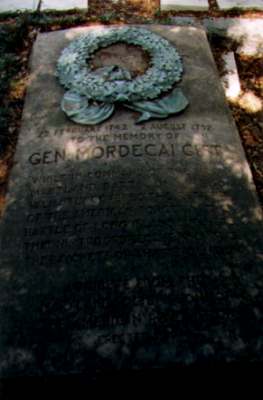
| But Mordecai Gist beat both of them for the ostentatiousness of his monument. (I assume this is the same Gist who ran afoul of a combined force of British Legion and Queen's Rangers near Yonkers, but I'm not really familiar with him.) |
| On our stroll through the city, we also had a quick look at the outside of the Miles Brewton house, also known as the Motte house, built between 1765 and 1769. During the Revolution it was the home of Brewton's sister, Rebecca Motte, and at various times, this perfectly preserved Georgian townhouse was used as residence and headquarters by Sir Henry Clinton, and later by Lord Rawdon. It is still privately owned by members of the Motte family, and is not open to the public. Unfortunately, the rather unfriendly fence makes taking a good picture of it pretty much impossible. |
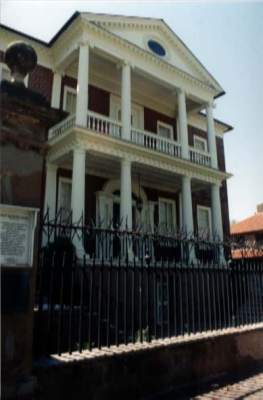
|
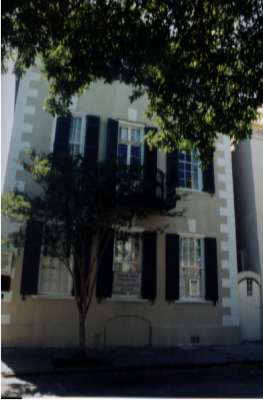
| A few blocks from the Miles Brewton house, we passed the Robert Brewton house (71 Church Street), built in 1721 and supposedly the oldest surviving single dwelling in the city. On a later visit to Charleston, I discovered it has an impossible Tarleton legend attached to it. According to one guide book, "Legend has it that during the British occupation in 1781, the mistress of the house was banished to Philadelphia by British Lt. Col. Tarleton. Tarleton had been insulted by remarks that Mrs. Brewton made in reference to his defeat by Col. Wm. Washington at Cowpens." Needless to say, this legend has no toe-hold in the realm of fact. After Cowpens, Tarleton went with Cornwallis's army on the long march north to Yorktown. He was nowhere near Charleston at any point in 1781.1 |
Since I first planned this trip, I've been trying to dig up the exact location of Banastre's quarters in Charleston, in case it was in one of the surviving historic homes. Unfortunately, while there are anecdotes galore about his time in the city, no one seems to have recorded exactly where he was billetted or the name of his unwilling hostess. [If anyone can enlighten me on this matter, I'd love to have the information for some future visit.]
And thus ends the Tarleton Tour, 2001. Next time around, I'll hopefully manage to take photographs of all the places that I didn't think to capture on film this time around.
| [ Index ] | [ Previous ] [ Next ] |
1 The quote comes from Nita Swann, The Complete Walking Tour of Historic Charleston (Charleston, S.C.: Charleston Publishing Company, n.d.), p10-11. [ back ]
| Return to the Main Page | Last updated by the Webmaster on January 30, 2004 |